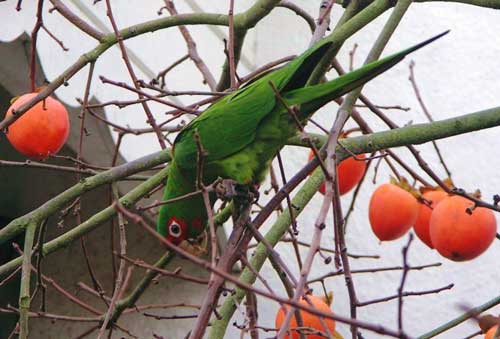 Berkeley mitred parakeet among persimmons. Photo Newton X. Liu Last week’s column, about Berkeley’s flock of parrots (or, depending on the source, parakeets or conures) drew a gratifying response. There are lots of keen observers out there, and I appreciate all your messages. Although some mysteries remain, it’s now possible to make a positive identification of the birds, map their cruising range, and draw a composite picture of their daily routine.
Berkeley mitred parakeet among persimmons. Photo Newton X. Liu Last week’s column, about Berkeley’s flock of parrots (or, depending on the source, parakeets or conures) drew a gratifying response. There are lots of keen observers out there, and I appreciate all your messages. Although some mysteries remain, it’s now possible to make a positive identification of the birds, map their cruising range, and draw a composite picture of their daily routine.
Based on the photographs of Newton X. Liu, Joel Karnofsky, and Steve Haflich, and several detailed verbal descriptions, the Berkeley parrots are clearly mitred parakeets (or, to aviculturists, mitred conures.) That’s a different species than the avian celebrities of Telegraph Hill, which are mostly red-masked parakeets (AKA cherry-headed conures) —although one San Francisco mitred parakeet paired with a red-masked, producing multiple broods of hybrids. The two forms are similar, but mitred parakeets have significantly less red on their heads.
Most correspondents reported a maximum of four parrots seen together—a much smaller flock than my memories from the ‘80s.
But Pam Zumwalt saw six in her south Berkeley neighborhood last July. Maybe the additional two were fledglings that subsequently died or struck out on their own.
The current flock seems to be composed entirely of adult birds, which have red foreheads and cheeks; young mitred parakeets have green cheeks. Could some be survivors of the original escapees who founded the local flock? I couldn’t find longevity data for mitreds, but red-masked parakeets have lived 26 years in captivity, and a bird of related species, the blue-headed parakeet, made it to 31.
With the exception of Zumwalt’s sighting near Ashby and Acton, most reports came from northwest Berkeley, clustering around James Kenney Park. I was tempted to start sticking colored pins in a map, like Tony Hillerman’s Lieutenant Joe Leaphorn, but I don’t have the wall space. Haflich writes that he has been seeing the birds around the park for 19 years. I scouted the area yesterday; no parrots, although I was surprised to find an apparent pair of white-tailed kites that may be planning to nest, which is pretty cool in itself.
“We are a mapping company located on the 2nd floor of a building on the corner of 7th and University,” writes Susan Waldorf. “Last Thursday, when all our patio doors and windows were open, I heard a very unusual bird sound. Just above us on the telephone wires were a pair of lovely parrots just like the flock on Telegraph Hill in SF (the movie about them is one of my all-time favorites). We watched them until they were chased away by a large crow or raven. Now I look everywhere in the trees of the neighborhood in hopes of a second sighting. We are only two blocks from James Kenney Park. Your article gives me hope that a flock will survive among us.”
Newton Liu has also seen the parrots “bullied by crows in the air” near Juanita and Rose. You have to wonder if Berkeley’s burgeoning crow population has contributed to the parrots’ decline—although as cavity nesters, they should be relatively secure from avian raiders like crows and ravens.
Sally Meeks reports parrot encounters near her workplace at 5th and Jones, and near Cedar and San Pablo. “They seem to like tall, scrappy pines in the neighborhood,” she writes. “I’ve seen them disappear into them at least twice now.”
As to what they’re eating, Ruth Tobey says the birds are regulars at a feeder on Tevlin Street, near Gilman: “They arrive between 8:30 and 9:30 in the morning and stay for at least 15 minutes each time. Sometimes they return in the afternoon … They are pretty ‘talkative’ and chatter while they take turns at the feeder.” Tobey says they favor the black oil sunflower seeds. And Liu and Paul Preston have documented their raids on persimmon trees.
No one seems to know where they nest, although Haflich speculates: “There may be nesting activity in the tall palms on the west side of 4th street between Cedar and Jones, or else in the trees along Cedar in that same block.” Pam Zumwalt writes: “I have seen (and heard), on and off over the last several years, two to four around Gilman and 6th, generally while we were leaving Picante, around sundown.” That suggests an evening roost somewhere nearby.
I was also unaware that the mitred parakeets are not the only free-range psittacines in town. Here’s Marilyn Pon: “I’ve been feeding a yellow-headed green amazon parrot who lives free in my neighborhood (near the Ashby BART station) for 15 years or so ... She comes by nearly every day and flies into my bedroom to a perch on my dresser.” Pon wonders about the amazon’s history, and so do I.
That’s the story so far. I’ll share any additional reports in a later column. And thanks again to all the parrot-spotters!